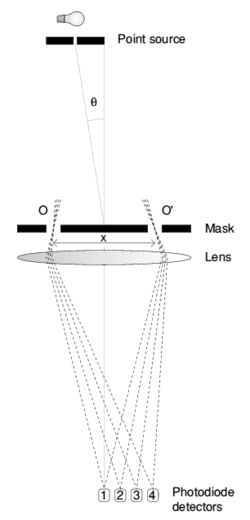Optical interferometry
|
|
| This article is in need of attention. |
| Please improve (https://academickids.com:443/encyclopedia/index.php?title=Optical_interferometry&action=edit) this article. |
Optical interferometry is a technique of interferometry combining light from multiple sources in an optical instrument in order to make various precise measurements.
The technique of optical interferometry can make use of white light, of monochromatic light (e.g., a sodium lamp) or of coherent monochromatic light (laser light). The main difference between these types of light is their coherence length: for white light, only a few wavelengths, but for laser light it can be decimeters or more. In order to see interference fringes at all, the optical path lengths travelled by the interfering beams or rays must differ by less than their correlation length.
| Contents |
Astronomical Optical Interferometry
Later, optical interferometry was used on the Mount Wilson Observatory's reflector telescope in order to measure the diameters of stars. This method was extended to measurements using separated telescopes by Johnson, Betz and Towns (1974) in the infrared and by Labeyrie (1975) in the visible. The red giant star Betelgeuse was among the first to have its diameter determined in this way. In the 1980s the aperture synthesis technique was extended to visible light and infrared astronomy by the Cavendish Astrophysics Group, providing the first very high resolution images of nearby stars. In 1995 this technique was demonstrated on an array of separate optical telescopes for the first time, allowing a further improvement in resolution, and allowing even higher resolution imaging of stellar surfaces (http://www.mrao.cam.ac.uk/telescopes/coast/astronomy.html#supergiants02-04). The same techniques have now been applied at a number of other astronomical telescope arrays, including the Navy Prototype Optical Interferometer, the VLTI, the CHARA array, the IOTA array and the MRO Interferometer. A detailed description of the development of astronomical optical interferometry can be found here (http://www.geocities.com/CapeCanaveral/2309/page1.html). Impressive results were obtained in the 1990s, with the Mark III measuring diameters of 100 stars and many accurate stellar positions, COAST and NPOI producing many very high resolution images, and ISI measuring stars in the mid-infrared for the first time. Some scientists exaggerated the benefits of combining large diameter (adaptive optics corrected) telescopes for near-infrared interferometry, and this left many astronomers disappointed with new arrays utilizing small numbers of large telescopes which came online in the early 2000s. For details of individual instruments, see the list of astronomical interferometers at visible and infrared wavelengths.
| Missing image Ast_opt_int_lba.gif |
 |
| A simple two-element optical interferometer. Light from two small telescopes (shown as lenses) is combined using beam splitters at detectors 1, 2, 3 and 4. The elements creating a 1/4 wave delay in the light allow the phase and amplitude of the interference visibility to be measured, which give information about the shape of the light source. | A single large telescope with an aperture mask over it (labelled Mask), only allowing light through two small holes. The optical paths to detectors 1, 2, 3 and 4 are the same as in the left-hand figure, so this setup will give identical results. By moving the holes in the aperture mask and taking repeated measurements, images can be created using aperture synthesis which would have the same quality as would have been given by the right-hand telescope without the aperture mask. In an analogous way, the same image quality can be achieved by moving the small telescopes around in the left-hand figure - this is the basis of aperture synthesis, using widely separated small telescopes to simulate a giant telescope. |
The Michelson-Morley experiment
Of the uses of optical interferometry mention should be made of the Michelson-Morley experiment, a test of the Special Theory of Relativity. Light travels along two alternative, mutually perpendicular paths, and meets again to form interference fringes. If the classical theory of absolute space and time and propagation of electromagnetic waves in a world aether are correct, rotating the whole device with respect to the direction of motion of the Earth should produce a shift in the interference fringes. No such shift was seen.
geodetic standard baseline measurements
A famous use of white light interferometry is the precise measurement of geodetic standard baselines as invented by Yrjö Väisälä. Here, the light path is split in two, and one leg is "folded" between a mirror pair 1 m apart. The other leg bounces once off a mirror 6 m away. Only if the second path is precisely 6 times the first, will fringes be seen.
Starting from a standard quartz gauge of 1 m length, it is possible to measure distances up to 864 m by repeated multiplication. Baselines thus established are used to calibrate geodetic distance measurement equipment on, leading to a metrologically traceable scale for geodetic networks measured by these instruments.
More modern geodetic applications of laser interferometry are in calibrating the divisions on levelling staffs, and in monitoring the free fall of a reflective prism within a ballistic or absolute gravimeter, allowing determination of gravity, i.e., the acceleration of free fall, directly from the physical definition at a few parts in a billion accuracy.
Holography
A special application of optical interferometry using coherent light is holography, a technique for photographically recording and re-displaying three-dimensional scenes. The technique also lends itself to monitoring small deformations.
Inertial Navigation
In inertial navigation, ring laser gyroscopes are used that can detect rotation through optical interferometry of laser beams travelling around a circumference in opposite directions (Sagnac interferometer). The effect is amplified by using optic fibres wound around thousands of times.
See also
External Links
- List of papers which chart the historical development of astronomical interferometry (http://web.archive.org/web/20050624033547/http://www.strw.leidenuniv.nl/~tubbs/classic_papers/)
- Description of one absolute gravimeter (http://pecny.asu.cas.cz/www/absgrave.html)
- Optical Long Baseline Interferometry News (http://olbin.jpl.nasa.gov/)
